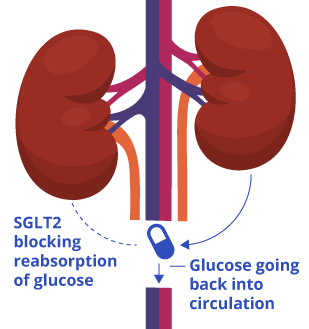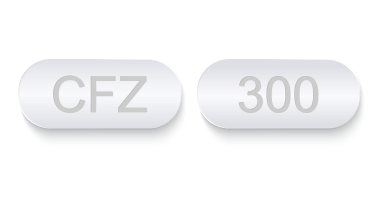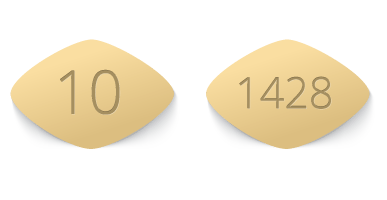SGLT2 Inhibitors
Sodium-glucose co-transporter 2 (SGLT2) inhibitors are a newer class of Type 2 diabetes drugs. They are growing in popularity because they are effective at lowering blood sugar. But they can also cause serious side effects including increased risk of amputations, diabetic ketoacidosis, and blood and kidney infections.
Doctors prescribe sodium-glucose co-transporter 2 (SGLT2) inhibitors to treat Type 2 diabetes.
These drugs include Invokana and Farxiga.
Unlike most other Type 2 diabetes drugs, SGLT2 inhibitors don’t act on the hormone insulin or the pancreas.
These drugs work by preventing the kidneys from reabsorbing glucose (sugar) and releasing it into the blood.

The kidneys are powerful glucose filters. SGLT2 is a glucose transporter found in the kidneys. It reabsorbs 90 percent of glucose and returns it to the blood.
SGLT2 inhibitors block SGLT2 and stop the reabsorption of glucose in the kidneys. Instead, the kidneys get rid of glucose through urine.
Studies show SGLT2 inhibitors are effective in controlling excess blood sugar in people with Type 2 diabetes. But potent blood sugar control also comes with side effects.
The U.S. Food and Drug Administration released warnings about side effects that can be fatal.
As of April 2022, more than 1,000 people had sued makers of SGLT2 inhibitors over failure to warn of the drugs’ risks.
SGLT2 Inhibitor Side Effects and FDA Warnings
SGLT2 inhibitors can cause serious side effects. The FDA has issued several warnings since the agency approved the first SGLT2 inhibitor in 2013.
The FDA required label changes to add new warnings and strengthen existing warnings. For the most serious injuries, the agency requires a black box warning.
| Serious Side Effect | Date | FDA Action |
|---|---|---|
| Amputation risk | May 2017 | Black box warning |
| Acute kidney injury | June 2016 | Stronger warnings |
| Urinary tract infections causing serious kidney and blood infections | December 2015 | New warnings |
| Bone fractures | September 2015 | Stronger warnings |
| Diabetic Ketoacidosis | May 2015 | New warnings |
SGLT2 inhibitors may pose a risk to fetuses. The drug should only be used during pregnancy if the potential benefit justifies or outweighs this risk.
These drugs are not for use in people with Type 1 diabetes or people with diabetic ketoacidosis.
Types of SGLT2 Inhibitors
Several brands of SGLT2 inhibitors are available in the U.S. Each drug comes in an oral tablet.
Canagliflozin, dapagliflozin and empagliflozin are active ingredients in SGLT2 inhibitors. Some also contain metformin.
All SGLT2 inhibitors work in relatively the same way. Some are also available in extended release formulas.
Invokana, Invokamet and Invokamet XR

Invokana (canagliflozin) became the first FDA-approved SGLT2 inhibitor.
Janssen Pharmaceuticals, a Johnson & Johnson company manufacturers the drug.
J&J spent $19.8 million marketing the drug to doctors in 2014, according to Bloomberg.
The FDA approved Invokomet and Invokamet XR soon after. Invokamet and its extended release version Invokamet XR combine canagliflozin with metformin.
In 2017, the FDA confirmed canagliflozin causes an increased risk of amputations. The agency required Johnson & Johnson to add a black box warning to the drugs’ labels.
The label change affects Invokana, Invokamet and Invokamet XR.
People who took Invokana and suffered amputation and other side effects are suing Johnson & Johnson. About 1,000 Invokana lawsuits remained pending in April 2018.
- Invokana - 100 mg and 300 mg tablets (people with kidney issues should not take more than 100 mg daily)
- Invokamet & Invokamet XR - 50 mg canagliflozin and 500 mg metformin (doses may be adjusted up to a maximum of 300 mg canagliflozin and 2000 mg metformin)
- Canagliflozin - Rifampin, digoxin
- Metformin - Alcohol, cimetidine, topiramate, zonisamide, acetazolamide
- Invokana - $300 for 30 tablets
- Invokamet & Invokamet XR - $453 for 60 tablets
- Amputations
- Diabetic ketoacidosis
- Kidney injury
- Urinary tract infections leading to blood infections
- Lactic acidosis (Invokamet and Invokamet XR)
- Bone fractures
- Invokana – 2013
- Invokamet – 2014
- Invokamet XR - 2016
Farxiga and Xigduo XR

Farxiga (dapagliflozin) was the second SGLT2 inhibitor formula to hit the U.S. market.
Xigduo XR is an extended release version that combines the active ingredient of Farxiga with metformin.
The FDA initially rejected Farxiga because of cancer concerns.
Farxiga has the typical side effects of other SGLT2s. Clinical trials revealed people who take it may be more likely to develop bladder cancer.
A federal judicial panel consolidated 60 Farxiga lawsuits in federal court.
The lawsuits blame manufacturers Bristol-Myers Squibb Co. and AstraZeneca for making a defective drug.
About 50 lawsuits remained pending as of April 2018.
- Farxiga - 5 mg and 10 mg tablets
- Xigduo XR - 5 mg dapagliflozin/500 mg metformin; 5 mg/1000 mg; 10 mg/500 mg; 10 mg/1000 mg tablets
- Dapagliflozin - Insulin, insulin secretagogues
- Metformin - Alcohol, cimetidine, topiramate, zonisamide, acetazolamide
- Farxiga – about $334 for 30 tablets
- Xigduo XR – about $457 for 30 tablets
- Bladder cancer
- Diabetic ketoacidosis
- Kidney injury
- Urinary tract infections leading to blood infections
- Lactic acidosis (Xigduo XR)
- Farxiga – January 2014
- Xigduo XR – October 2014
Jardiance, Glyxambi and Synjardy
The FDA approved Jardiance (empagliflozin) in 2014. Boehringer Ingelheim sells the drug.
Glyxambi (empagliflozin and linagliptin) and Synjardy belong to the group of Jardiance medications.
Glyxambi combines the active ingredients in Jardiance with the active ingredient in another Type 2 diabetes medicine called Tradjenta.
Synjardy combines empagliflozin with metformin.
At higher doses, animal studies showed empagliflozin caused kidney problems.
- Jardiance - 10 mg and 25 mg tablets
- Glyxambi - 10 mg empagliflozin/5 mg linagliptin; 25 mg empagliflozin/5 mg linagliptin
- Synjardy - 5 mg empagliflozin/500 mg metformin hydrochloride; 5 mg empagliflozin/1000 mg metformin hydrochloride; 12.5 mg empagliflozin/500 mg metformin hydrochloride; 12.5 mg empagliflozin/1000 mg metformin hydrochloride tablets
- Empagliflozin - Diuretics, insulin, insulin secretagogues
- Linagliptin - Rifampin
- Metformin - Alcohol, cimetidine, topiramate, zonisamide, acetazolamide
- Jardiance – about $350 to $400 for 30 tablets
- Glyxambi – about $562 for 30 tablets
- Synjardy – about $457 for 60 tablets
- Pancreatitis and pancreatic cancer (Glyxambi)
- Heart failure (Glyxambi)
- Diabetic ketoacidosis
- Kidney injury
- Urinary tract infections leading to blood infections
- Lactic acidosis (Synjardy)
- Jardiance - 2014
- Glyxambi – January 2015
- Synjardy – August 2015
Calling this number connects you with a Drugwatch.com representative. We will direct you to one of our trusted legal partners for a free case review.
Drugwatch.com's trusted legal partners support the organization's mission to keep people safe from dangerous drugs and medical devices. For more information, visit our partners page.


